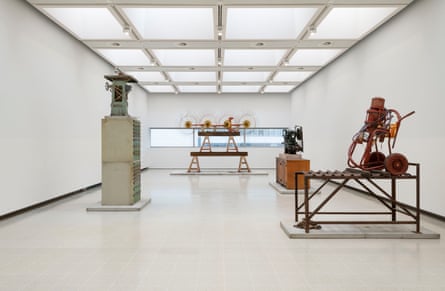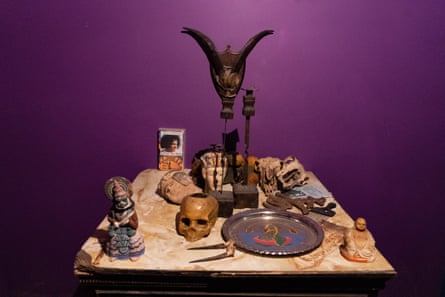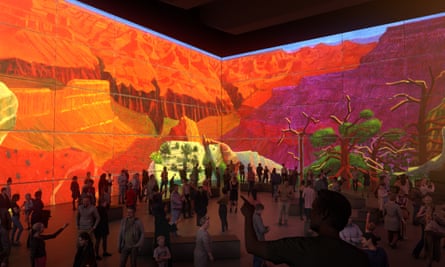[ad_1]
You enter, stage right, through an unfamiliar door straight into a storeroom. Corridors of shelves bear nameless bubble-wrapped objects, old doors of all sorts are propped against the walls. Oak fitted with barred grilles and ancient locks, reinforced metal, painted panels pierced with Stars of David: why are they here? As in life, so in art: you are immediately looking for clues.
The body parts of a building, perhaps, except that the winding warren points to an entire city. Italian lettering appears on a sack. Stencilled numbers hint at the Venetian ghetto. Red darkroom lights cast a fixed glow over it all, as if you were walking through a monochrome photograph. It feels like an image of reality and yet also the reality itself. A label on a swaddled armchair seems to allude to this cognitive mystery. Back Room, it reads – both an instruction to some notional handler, but also a pun on the place in which you find yourself, here and in the artist’s milieu.
Mike Nelson, at 55, is a master of these fictive installations through which the visitor passes never knowing what they will encounter or how the story will end. Twice shortlisted for the Turner prize, Britain’s representative at the 2011 Venice Biennale, he is internationally exhibited and renowned. In the past, he often invoked the absence of some imaginary presence – surveillance photographers, Gulf war vets, prisoners, political thinkers. But the Hayward’s gigantic anthology feels far more like a journey through the singular and complex mind of the artist himself.
The storeroom’s many doors are portals for the imagination, but they are also preludes of what is to come. Leave and you instantly encounter five more – the doors of the Hayward itself, one of them an exit you no longer quite trust. Nelson makes the real architecture of the gallery seem false.

Up a ramp through another door and the front desk of an empty office seems strangely high and the whirring fan sinister. Rickety corridors lead to other doors, other rooms. You are suddenly abroad, trying to book a flight from Nairobi to New York (the Twin Towers are sealed up in a period snowglobe). You are in a sweatshop in India, rags all over the floor. You are on a ferry, at the captain’s bar where a wax hand clutches an eyeball and you can impersonate Elvis in a special mirror.
A door appears sealed, but you can wrench it open. The lights are permanently on – try any of the switches. Nelson is surely unique in allowing everything he makes to be tested and touched. There are moments of sudden anxiety. A door creaks open to reveal a sleeping bag that appears to be still in use. The shadow of a light fitting looks like a man with his arms up – don’t shoot.
Nelson has a miniaturist’s eye for the vignette – a payphone, a fag butt, a number urgently scribbled on the wall – and a dramatist’s gift for tableaux. A filthy old table in one room is pure Freud: skulls, clay deities, ibex horns, totems. Go round the side and there’s charred wood on the floor as if something was ritually burned. It feels like a shrine to lost gods.

It’s getting hotter. There are more rags. The doors multiply until there are three or even four to choose from down every corridor. A huge pair of scissors lies menacingly on a bench. You think you know your way round the maze, but there is this mounting unease. Have you been everywhere, where are you, what have you missed (in art, as in life)?
And this is how it goes through the whole show. You move from this vast labyrinth to a narrow stairwell where the sleeping bag has become a stone sarcophagus for the unknown dead. At the top of the stairs, the scale shifts again and a doorway frames a colossal vista of bunkers marooned in a desert of sand as it if were a panoramic painting. But two dimensions turn into three as you enter a winding tunnel that leads to another darkroom, where the prints show scenes of long ago (except that some seem oddly familiar) and you find yourself inside that very bunker looking back to where you perhaps once stood. But the walls are too high: memory, and agency, blocked.
My sense is of a greater freedom by far to Nelson’s art in this enthralling show. Previous installations have been reconfigured beyond recognition, tendentious clues removed. The work feels open to the limits of our imagination. You don’t have to know that the US land artist Robert Smithson is invoked in that buried building to feel the amazement of a gallery silted up with sand, the bunker projecting like the Statue of Liberty in Planet of the Apes. A room only has to contain a prayer stool positioned at a particular angle to be more pressurised than peaceful. And even when a scene appears to have a focused backstory – a pilot’s jacket, a roulette wheel, a chair knocked to the floor – the time, place and action are all in your gift. You are both dramatist and audience.
The largest of these environments is conceived like hundreds of open rebar cells through which you perceive life-size sculpted heads: a thinking space. The smallest is a recreation of Nelson’s old studio, strewn with junk like the workshop of a nutter. But it is from all this stuff that he has so diligently constructed these chambers of the mind that put you on the spot with their irresistible enigmas. And what counts is the way in which these fictions are not just conjured from real fragments, but gibe with reality itself. It seems like a dream but you really were there, touching the Venetian doors, the Nairobi snowglobe. Nelson’s worlds partake of a reality they also invent.
There is never an idle moment in David Hockney’s art, projected in all its spectacular radiance across every surface of London’s new four-storey Lightroom. Images stream, zoom and scintillate, proliferating in dazzling dayglo, flooding floor and walls with luminous rain, glowing moons and the diagrammatic ripples of his magnificent LA pools. The viewer is spellbound and dwarfed.

His graphic genius lends itself perfectly to digital manipulation. The vast Grand Canyon paintings, nuclear orange, now expand all around you. The sharp portraits of Californian collectors loom like living giants in the fizzing sun. A road movie shows Hockney hurtling through the Californian hills to Wagner’s Ride of the Valkyries, then it’s a quick splash to the arrival of spring in Normandy, in gargantuan iPad drawings that record every moment of their own making.
Unlike the immersive Van Gogh or Kahlo experiences – to which this is enormously superior – Hockney is present throughout as a disembodied voice giving what amounts to a 360° lantern-lecture. Old chestnuts about single-point perspective and the camera obscura alternate, across 50 minutes, with avuncular injunctions to love life and look harder, as he (of course) does. Yet Hockney’s still images generally flick past much too fast for such attention.
Which may be why, paradoxically, the most absorbing moments come through the creative team’s animations of his art. A Chinese scroll unfurls slowly around the walls. Theatre curtains gradually rise to reveal dancing figures. A single line, exquisitely inflected, extends into a whole blue ocean. The sight is magical, a digital feat, and then swiftly gone. Perfectly apt for late Hockney, ever the restless techno-pioneer.
Star ratings (out of five)
Mike Nelson ★★★★★
David Hockney: Bigger and Closer ★★★★
[ad_2]
READ SOURCE


